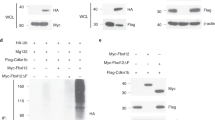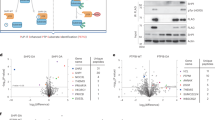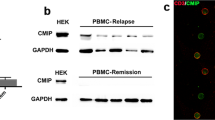Abstract
Signaling via the T cell antigen receptor (TCR) is initiated by Src-family kinases (SFKs). To understand how the kinase Csk, a negative regulator of SFKs, controls the basal state and the initiation of TCR signaling, we generated mice that express a Csk variant sensitive to an analog of the common kinase inhibitor PP1 (CskAS). Inhibition of CskAS in thymocytes, without engagement of the TCR, induced potent activation of SFKs and proximal TCR signaling up to phospholipase C-γ1 (PLC-γ1). Unexpectedly, increases in inositol phosphates, intracellular calcium and phosphorylation of the kinase Erk were impaired. Altering the actin cytoskeleton pharmacologically or providing costimulation via CD28 'rescued' those defects. Thus, Csk has a critical role in preventing TCR signaling. However, our studies also revealed a requirement for actin remodeling, initiated by costimulation, for full TCR signaling.
This is a preview of subscription content, access via your institution
Access options
Subscribe to this journal
Receive 12 print issues and online access
$209.00 per year
only $17.42 per issue
Buy this article
- Purchase on Springer Link
- Instant access to full article PDF
Prices may be subject to local taxes which are calculated during checkout






Similar content being viewed by others
References
Smith-Garvin, J.E., Koretzky, G.A. & Jordan, M.S. T cell activation. Annu. Rev. Immunol. 27, 591–619 (2009).
van Oers, N.S., Killeen, N. & Weiss, A. ZAP-70 is constitutively associated with tyrosine-phosphorylated TCR ζ in murine thymocytes and lymph node T cells. Immunity 1, 675–685 (1994).
Xu, C. et al. Regulation of T cell receptor activation by dynamic membrane binding of the CD3ɛ cytoplasmic tyrosine-based motif. Cell 135, 702–713 (2008).
James, J.R. & Vale, R.D. Biophysical mechanism of T-cell receptor triggering in a reconstituted system. Nature 487, 64–69 (2012).
van der Merwe, P.A. & Dushek, O. Mechanisms for T cell receptor triggering. Nat. Rev. Immunol. 11, 47–55 (2011).
Palacios, E.H. & Weiss, A. Function of the Src-family kinases, Lck and Fyn, in T-cell development and activation. Oncogene 23, 7990–8000 (2004).
Bergman, M. et al. The human p50csk tyrosine kinase phosphorylates p56lck at Tyr-505 and down regulates its catalytic activity. EMBO J. 11, 2919–2924 (1992).
Hermiston, M.L., Xu, Z., Majeti, R. & Weiss, A. Reciprocal regulation of lymphocyte activation by tyrosine kinases and phosphatases. J. Clin. Invest. 109, 9–14 (2002).
Nika, K. et al. Constitutively active Lck kinase in T cells drives antigen receptor signal transduction. Immunity 32, 766–777 (2010).
Imamoto, A. & Soriano, P. Disruption of the csk gene, encoding a negative regulator of Src family tyrosine kinases, leads to neural tube defects and embryonic lethality in mice. Cell 73, 1117–1124 (1993).
Nada, S. et al. Constitutive activation of Src family kinases in mouse embryos that lack Csk. Cell 73, 1125–1135 (1993).
Schmedt, C. et al. Csk controls antigen receptor-mediated development and selection of T-lineage cells. Nature 394, 901–904 (1998).
Cloutier, J.F., Chow, L.M. & Veillette, A. Requirement of the SH3 and SH2 domains for the inhibitory function of tyrosine protein kinase p50csk in T lymphocytes. Mol. Cell. Biol. 15, 5937–5944 (1995).
Brdicka, T. et al. Phosphoprotein associated with glycosphingolipid-enriched microdomains (PAG), a novel ubiquitously expressed transmembrane adaptor protein, binds the protein tyrosine kinase csk and is involved in regulation of T cell activation. J. Exp. Med. 191, 1591–1604 (2000).
Davidson, D., Bakinowski, M., Thomas, M.L., Horejsi, V. & Veillette, A. Phosphorylation-dependent regulation of T-cell activation by PAG/Cbp, a lipid raft-associated transmembrane adaptor. Mol. Cell. Biol. 23, 2017–2028 (2003).
Kawabuchi, M. et al. Transmembrane phosphoprotein Cbp regulates the activities of Src-family tyrosine kinases. Nature 404, 999–1003 (2000).
Xavier, R., Brennan, T., Li, Q., McCormack, C. & Seed, B. Membrane compartmentation is required for efficient T cell activation. Immunity 8, 723–732 (1998).
Dobenecker, M.W., Schmedt, C., Okada, M. & Tarakhovsky, A. The ubiquitously expressed Csk adaptor protein Cbp is dispensable for embryogenesis and T-cell development and function. Mol. Cell. Biol. 25, 10533–10542 (2005).
Xu, S., Huo, J., Tan, J.E. & Lam, K.P. Cbp deficiency alters Csk localization in lipid rafts but does not affect T-cell development. Mol. Cell. Biol. 25, 8486–8495 (2005).
Schoenborn, J.R., Tan, Y.X., Zhang, C., Shokat, K.M. & Weiss, A. Feedback circuits monitor and adjust basal Lck-dependent events in T cell receptor signaling. Sci. Signal. 4, ra59 (2011).
Gamper, C.J. & Powell, J.D. All PI3Kinase signaling is not mTOR: dissecting mTOR-dependent and independent signaling pathways in T cells. Front. Immunol. 3, 312 (2012).
Berridge, M.J. Inositol trisphosphate and calcium signalling mechanisms. Biochim. Biophys. Acta 1793, 933–940 (2009).
Kortum, R.L. et al. A phospholipase C-γ1-independent, RasGRP1-ERK-dependent pathway drives lymphoproliferative disease in linker for activation of T cells-Y136F mutant mice. J. Immunol. 190, 147–158 (2013).
Kusumi, A. et al. Paradigm shift of the plasma membrane concept from the two-dimensional continuum fluid to the partitioned fluid: high-speed single-molecule tracking of membrane molecules. Annu. Rev. Biophys. Biomol. Struct. 34, 351–378 (2005).
Blin, G. et al. Quantitative analysis of the binding of ezrin to large unilamellar vesicles containing phosphatidylinositol 4,5 bisphosphate. Biophys. J. 94, 1021–1033 (2008).
Gambhir, A. et al. Electrostatic sequestration of PIP2 on phospholipid membranes by basic/aromatic regions of proteins. Biophys. J. 86, 2188–2207 (2004).
Treanor, B. et al. The membrane skeleton controls diffusion dynamics and signaling through the B cell receptor. Immunity 32, 187–199 (2010).
Klein, L., Hinterberger, M., Wirnsberger, G. & Kyewski, B. Antigen presentation in the thymus for positive selection and central tolerance induction. Nat. Rev. Immunol. 9, 833–844 (2009).
Proietto, A.I., Lahoud, M.H. & Wu, L. Distinct functional capacities of mouse thymic and splenic dendritic cell populations. Immunol. Cell Biol. 86, 700–708 (2008).
Burkhardt, J.K., Carrizosa, E. & Shaffer, M.H. The actin cytoskeleton in T cell activation. Annu. Rev. Immunol. 26, 233–259 (2008).
Veillette, A., Bookman, M.A., Horak, E.M. & Bolen, J.B. The CD4 and CD8 T cell surface antigens are associated with the internal membrane tyrosine-protein kinase p56lck. Cell 55, 301–308 (1988).
Steinman, R.M. Decisions about dendritic cells: past, present, and future. Annu. Rev. Immunol. 30, 1–22 (2012).
Boomer, J.S. & Green, J.M. An enigmatic tail of CD28 signaling. Cold Spring Harb. Perspect. Biol. 2, a002436 (2010).
Salazar-Fontana, L.I., Barr, V., Samelson, L.E. & Bierer, B.E. CD28 engagement promotes actin polymerization through the activation of the small Rho GTPase Cdc42 in human T cells. J. Immunol. 171, 2225–2232 (2003).
Liang, Y. et al. The lymphoid lineage-specific actin-uncapping protein Rltpr is essential for costimulation via CD28 and the development of regulatory T cells. Nat. Immunol. 14, 858–866 (2013).
Abraham, R.T. & Weiss, A. Jurkat T cells and development of the T-cell receptor signalling paradigm. Nat. Rev. Immunol. 4, 301–308 (2004).
Saarikangas, J., Zhao, H. & Lappalainen, P. Regulation of the actin cytoskeleton-plasma membrane interplay by phosphoinositides. Physiol. Rev. 90, 259–289 (2010).
Valitutti, S., Dessing, M., Aktories, K., Gallati, H. & Lanzavecchia, A. Sustained signaling leading to T cell activation results from prolonged T cell receptor occupancy. Role of T cell actin cytoskeleton. J. Exp. Med. 181, 577–584 (1995).
Kraus, M., Alimzhanov, M.B., Rajewsky, N. & Rajewsky, K. Survival of resting mature B lymphocytes depends on BCR signaling via the Igα/β heterodimer. Cell 117, 787–800 (2004).
Polic, B., Kunkel, D., Scheffold, A. & Rajewsky, K. How αβ T cells deal with induced TCR α ablation. Proc. Natl. Acad. Sci. USA 98, 8744–8749 (2001).
Gross, J.A., Callas, E. & Allison, J.P. Identification and distribution of the costimulatory receptor CD28 in the mouse. J. Immunol. 149, 380–388 (1992).
Buhlmann, J.E., Elkin, S.K. & Sharpe, A.H. A role for the B7–1/B7–2:CD28/CTLA-4 pathway during negative selection. J. Immunol. 170, 5421–5428 (2003).
Dautigny, N., Le Campion, A. & Lucas, B. Timing and casting for actors of thymic negative selection. J. Immunol. 162, 1294–1302 (1999).
Holdorf, A.D. et al. Proline residues in CD28 and the Src homology (SH)3 domain of Lck are required for T cell costimulation. J. Exp. Med. 190, 375–384 (1999).
van Rheenen, J. et al. EGF-induced PIP2 hydrolysis releases and activates cofilin locally in carcinoma cells. J. Cell Biol. 179, 1247–1259 (2007).
Patsoukis, N. et al. RIAM regulates the cytoskeletal distribution and activation of PLC-γ1 in T cells. Sci. Signal. 2, ra79 (2009).
Tischer, B.K., von Einem, J., Kaufer, B. & Osterrieder, N. Two-step red-mediated recombination for versatile high-efficiency markerless DNA manipulation in Escherichia coli. Biotechniques 40, 191–197 (2006).
Sligh, J.E. Jr. et al. Inflammatory and immune responses are impaired in mice deficient in intercellular adhesion molecule 1. Proc. Natl. Acad. Sci. USA 90, 8529–8533 (1993).
Borriello, F. et al. B7–1 and B7–2 have overlapping, critical roles in immunoglobulin class switching and germinal center formation. Immunity 6, 303–313 (1997).
Chow, L.M., Fournel, M., Davidson, D. & Veillette, A. Negative regulation of T-cell receptor signalling by tyrosine protein kinase p50csk. Nature 365, 156–160 (1993).
Gasteiger, E. et al. Protein identification and analysis tools on the ExPASy server. in The Proteomics Protocols Handbook (ed. Walker, J.M.) 571–607 (Humana, 2005).
Barker, S.C. et al. Characterization of pp60c-src tyrosine kinase activities using a continuous assay: autoactivation of the enzyme is an intermolecular autophosphorylation process. Biochemistry 34, 14843–14851 (1995).
Sondhi, D., Xu, W., Songyang, Z., Eck, M.J. & Cole, P.A. Peptide and protein phosphorylation by protein tyrosine kinase Csk: insights into specificity and mechanism. Biochemistry 37, 165–172 (1998).
Acknowledgements
We thank J.A. Bluestone (University of California, San Francisco) for CD80-CD86–deficient mice; J.B. Bolen (Moderna Therapeutics) for the anti-Lck hybridoma; H. Wang (University of California, San Francisco) for anti-ζ; A. Roque and Z. Wang for assisting with animal husbandry and cell sorting, respectively; N. Killeen and Z. Yang for technical assistance with BAC transgenesis; J.S. Shin for technical assistance with isolation of thymic DCs; H. Liu and the University of California, San Francisco Helen Diller Family Comprehensive Cancer Center Mass Spectrometry Core Facility for technical and analytical expertise; and A. DeFranco, C. Lowell and H. Wang for critical reading of the manuscript and discussions. Supported by the Agency for Science, Technology and Research in Singapore (Y.X.T.), the Cancer Research Institute (B.N.M.) and the US National Institutes of Health (PO1 AI091580 to A.W. and 5R01EB001987 to K.M.S.).
Author information
Authors and Affiliations
Contributions
Y.X.T. and A.W. designed the research and wrote the manuscript; Y.X.T. did the research and analyzed the data; B.N.M. helped design, do and analyze the immunofluorescence experiments; T.S.F. designed, did and analyzed the data from the in vitro kinase assays; C.Z. and K.M.S. designed the CskAS allele and provided 3-IB-PP1; and all authors commented on the manuscript.
Corresponding author
Ethics declarations
Competing interests
The authors declare no competing financial interests.
Integrated supplementary information
Supplementary Figure 1 The CskAS protein is active and can be specifically inhibited by the PP1 analog 3-IB-PP1.
(a) Substituting glycine for threonine at the gatekeeper position in the active site of Csk to generate analog sensitive Csk (CskAS) impairs but does not abrogate kinase activity in purified CskAS, as monitored by decreasing absorbance in an assay coupling ATP hydrolysis to NADH oxidation. (b) CskAS phosphorylates peptide at a rate in between that of CskWT and the kinase-impaired variant CskK222R. Error bars represent 95% confidence intervals (CI), n=4. The Csk variants are significantly different from each other (p<0.0001) in a one-way ANOVA test (or p=0.0041 (CskAS, CskK222R) in a two-tailed t test). (c) A bulky analog of kinase inhibitor PP1, 3-IB-PP1, specifically targets CskAS over CskWT. Data points are independent samples from four (CskWT) or five (CskAS) separate experiments, and lines represent fit dose-response curves. (d) 3-IB-PP1 has a 27-fold lower IC50 for CskAS than for CskWT. Error bars represent 95% CI of a global fit.
Supplementary Figure 2 T cells develop normally and respond normally to TCR stimulation in CskAS BAC transgenic mice.
(a) Immunoblot and densitometric analysis of Csk expression in wild-type (WT) and CskAS(AS) thymocytes. (b) Thymocytes or splenocytes from wild-type (WT) and CskAS(AS) thymi were surface stained for the indicated markers and analyzed by flow cytometry. Data are representative of five littermate pairs. (c) Mean thymic cellularity of ten wild-type (WT) and ten CskAS(AS) littermate thymi with means and s.e.m indicated. (d) Thymocytes from wild-type (WT:thin lines) or CskAS (AS:thick lines) mice loaded with Indo-1AM dye were stimulated with high dose (red lines: 20μg/mL) or low dose (blue lines: 5μg/mL) anti-CD3ɛ. Ratiometric assessment of intracellular calcium of CD4+CD8+ thymocytes over time is shown. Data are representative of three independent experiments.
Supplementary Figure 3 Inhibition of CskAS induces tyrosine phosphorylation but not CD69 upregulation in primary mouse T cells.
(271) Lighter exposure of pTyr blot from Figure 1d with quantification of p21 normalized to total ζ immunoprecipitated. (b) Immunoblot analysis of phosphorylated Akt or actin (loading control) in wild-type (WT) or CskAS (AS) thymocytes treated for 3min with DMSO, 10 μM 3-IB-PP1 or 20 μg/Ml anti-CD3ɛ. (c) Thymocytes from wild-type (WT) or CskAS (AS) mice were treated with DMSO, 10 μM 3-IB-PP1 or 10 μg/ml platebound anti-CD3ɛ for 12 hours, stained for cell surface CD69 and analyzed by flow cytometry, gated on CD4+CD8+ thymocytes. (d) Immunoblot analysis of phosphorylated tyrosine (p-Tyr) and Erk2 (loading control) in wild-type (WT) or CskAS (AS) purified peripheral CD4+ T cells treated for 3min as in b. (e) Immunoblot analysis of total and phosphorylated (p-) Zap70, Lat and PLC-γ1 in wild-type (WT) or CskAS (AS) purified peripheral CD4+ T cells treated for 3min as in b. Data are representative of two (d) or three (a-c and e) independent experiments.
Supplementary Figure 4 Simultaneous alteration of the actin cytoskeleton enhances Erk phosphorylation in thymocytes after inhibition of CskAS.
Phosphorylated Erk in wild-type (WT) or CskAS (AS) thymocytes stimulated for 2 min as indicated (10 μM 3-IB-PP1; CytoD, 10 μM cytochalasin D; LatA, 0.5 μM latrunculin A; Jpk, 1 μM jasplakinolide; 20 μg/mL anti-CD3ɛ), gated on CD4+CD8+ thymocytes. Data are representative of two independent experiments. Numbers above bracketed lines indicate percent cells with phosphorylated Erk.
Supplementary Figure 5 Thymic DCs, but not naive splenic DCs, ICAM-1 deficient DCs or chemokines secreted by mature splenic DCs, enhance Erk phosphorylation in thymocytes after CskAS inhibition.
Phosphorylated Erk in CskAS thymocytes (a, b and d) or in wild-type (WT) and CskAS (AS) thymocytes (c) pelleted with or without DCs at a 1:1 ratio and stimulated with vehicle (DMSO), 10 μM 3-IB-PP1, 50 ng/mL phorbol myristate acetate (PMA) (a-d) and 10 ng/mL stromal cell-derived factor (SDF-1) (d) for 3min, gated on CD4+CD8+ thymocytes. Numbers above bracketed lines indicate percent cells with phosphorylated Erk. (a) Naïve DCs were enriched from wild-type splenocytes and used immediately. (b) Thymic DCs were sorted from wild-type thymi as described in methods. (c) DCs were enriched from wild-type (WT) or ICAM-1 deficient (ICAM-1 KO) splenocytes and activated by overnight culture. (d) Thymocytes from CskAS mice were treated with DMSO or 50 ng/mL pertussis toxin (PTx) for 1h before mixing with DCs enriched from wild-type splenocytes and activated by overnight culture. Data are representative of two (a, d) or three (b, c) independent experiments.
Supplementary Figure 6 Model for TCR signal initiation and propagation in thymocytes.
(a) Perturbing the Csk-CD45 equilibrium regulating Lck by inhibiting CskAS results in potent Lck activation, thereby initiating phosphorylation of CD3 and ζ ITAMs and Zap70, and eventually activation of PLC-γ1 bound to the Lat signalosome. However, in the absence of actin turnover, active PLC-γ1 cannot access plasma membrane PtdIns(4,5)P2 to hydrolyze it because the dense cortical actin meshwork and its associated proteins may act as a barrier or because PLC-γ1 fails to be recruited to the actin cytoskeleton. (b) Inducing remodeling of the cortical actin cytoskeleton with cytochalasin D allows active PLC-γ1 to access and hydrolyze PtdIns(4,5)P2 to generate diacylglycerol (DAG) and Ins(1,4,5)P3. (c) During a thymocyte-APC interaction, TCR engagement by pMHC recruits CD4 or CD8 coreceptor bound active Lck. Association of CD80 or CD86 engaged CD28 with Lck allows for activation of local actin cytoskeletal remodeling. (d) This enables active PLC-γ1 to hydrolyze PtdIns(4,5)P2.
Supplementary information
Supplementary Text and Figures
Supplementary Figures 1–6 (PDF 4893 kb)
Rights and permissions
About this article
Cite this article
Tan, Y., Manz, B., Freedman, T. et al. Inhibition of the kinase Csk in thymocytes reveals a requirement for actin remodeling in the initiation of full TCR signaling. Nat Immunol 15, 186–194 (2014). https://doi.org/10.1038/ni.2772
Received:
Accepted:
Published:
Issue Date:
DOI: https://doi.org/10.1038/ni.2772
This article is cited by
-
The phosphatidylinositol-transfer protein Nir3 promotes PI(4,5)P2 replenishment in response to TCR signaling during T cell development and survival
Nature Immunology (2023)
-
SH3-domain mutations selectively disrupt Csk homodimerization or PTPN22 binding
Scientific Reports (2022)
-
Proteomic characterization of Omicron SARS-CoV-2 host response
Cell Discovery (2022)
-
Function of γδ T cells in tumor immunology and their application to cancer therapy
Experimental & Molecular Medicine (2021)
-
CD45 pre-exclusion from the tips of T cell microvilli prior to antigen recognition
Nature Communications (2021)



